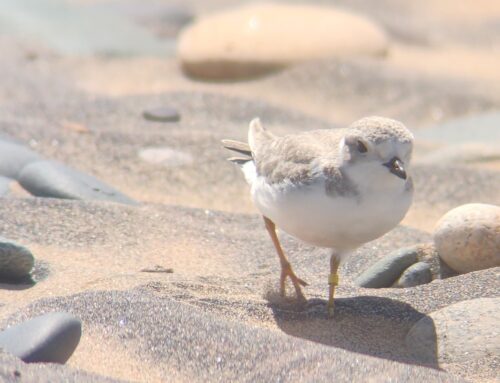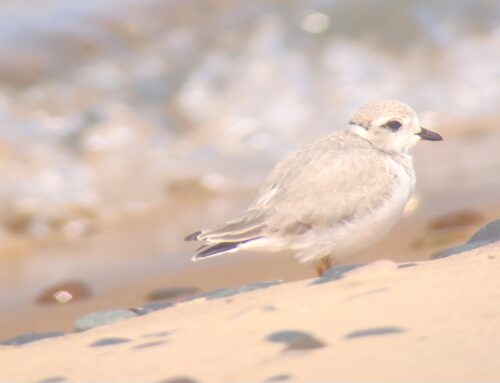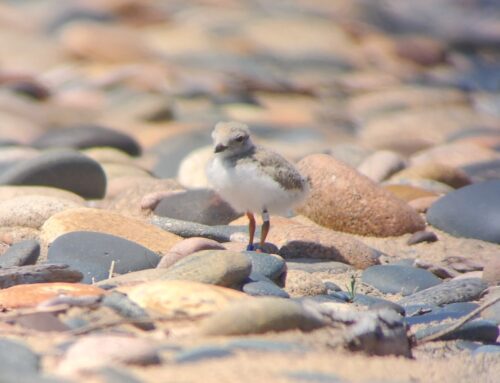Early, early, mornings. These are the first three words that come to mind when I think about this last week in the field. While anywhere else, these simple words may be quite unwelcome, here at Whitefish Point, they are a blessing. While shooting a soon-to-be-released video project about what to expect when visiting Whitefish Point, I’ve started many mornings by waking up between 4 and 5 a.m. to catch the sunrise over Lake Superior. Aside from the beautiful golden light and orange sky, this exercise always maximizes the day’s potential for unique bird sightings. In addition to developing new favorites such as the Common Yellowthroat, a bird which I appreciate for its bandit-like mask and wavering call, I’ve seen rare birds for this time of year, such as the American Tree Sparrow. When I finally realized days after seeing it that I had taken photos of an American Tree Sparrow and not a similar-looking, more common species, my first thought was, “Shouldn’t you be in Canada by now?”

An American Tree Sparrow at Whitefish Point. Photo by Blake Carlile.
I’ve also seen birds that, although they are not entirely rare or uncommon, produced unexpected moments of joy. For example, since arriving at Whitefish Point, I’ve heard several stories from friends and coworkers about their first experience seeing an Indigo Bunting. While I don’t remember the exact details of their vivid descriptions of the bird, the words amazing, brilliant, and neon come to mind. Having never seen one myself, I had my doubts. After all, as I’ve quickly come to learn, birders can be akin to fishermen in their eagerness to portray every notable catch, or in this case bird sighting, as the wild goose chase of a lifetime. Perhaps I thought they were exaggerating just a little bit. So it was to my surprise that, while walking the crisscrossing trails of Whitefish Point’s forest area, I saw two electric blue bolts of lightning streak through the trees. Knowing what I was seeing but shocked that any such bird could exist this far away from the nearest tropical rainforest, I fumbled with my camera and took five blurry photos that didn’t even come close to capturing the two male Indigo Buntings. I spent the rest of the morning listening for their calls and keeping one step behind them, hoping they would come back. While they never got close enough for a good photo, I was enthralled by how a dark, unassuming songbird could so quickly become a radiant blue when touched by the light of the morning sun.
In addition to my bird sightings, I have had the pleasure of seeing several new and interesting species of insects. While I don’t care for the influx of mosquitos and biting flies that have become my new entourage through the woods, I have enjoyed the many beautiful butterflies which often flutter into my view. I have also had the privilege (or lack thereof) of seeing the first bald-faced hornet of my lifetime. While I’m no entomologist, my instincts tell me that my choice to stay 15 feet away from the thing at all times was the right one.

A northern crescent butterfly rests on a flower. Photo by Blake Carlile.

A bald-faced hornet clings to a bush. Photo by Blake Carlile
I would like to end this blog with an announcement. Starting today, I will be holding office hours in the Owl’s Roost Gift Shop from 3 to 5 p.m. on Fridays, Saturdays, and Sundays. Feel free to drop by and ask questions, check out the educational materials and taxidermy within the building, or just chat with me about birds!
Until next week,
Blake Carlile
2021 Summer Outreach Intern
Featured Photo: An American Tree Sparrow in the grass by the boardwalk at Whitefish Point. This is an extremely uncommon bird to be seeing this far south in the summer. Photo by Blake Carlile.
You can read Blake’s weekly blog posts and follow WPBO’s social media (Facebook, Instagram, and Twitter) for more highlights of his experiences this season.






